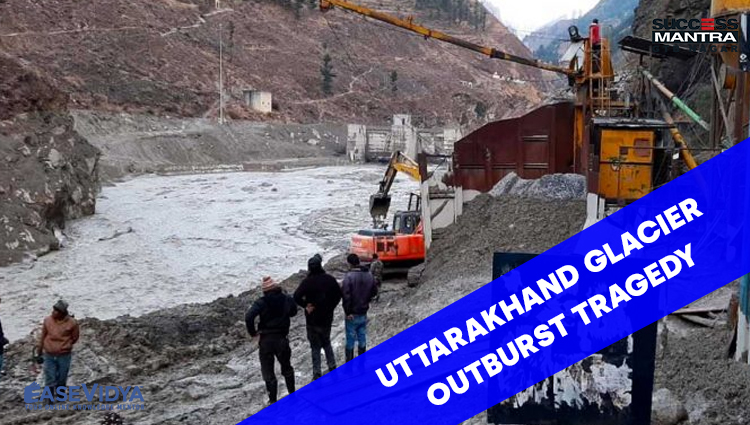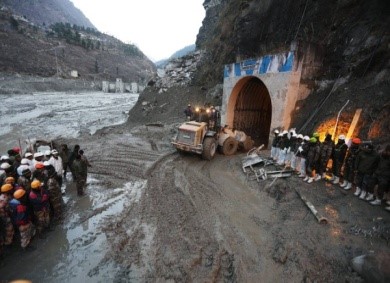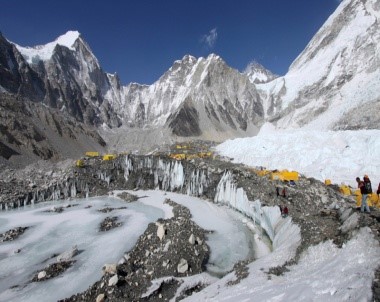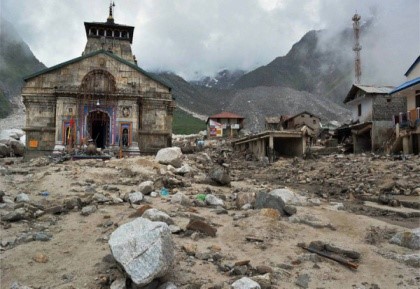
UTTARAKHAND GLACIER OUTBURST TRAGEDY
UTTARAKHAND GLACIER OUTBURST TRAGEDY

Another massive tragedy struck Uttarakhand on February 7, 2020 when a glacier burst took place in Chamoli district of the state. A large piece of Nanda Devi glacier broke off on a chilly winter morning of February and fell into a river, triggering an avalanche and glacial lake outburst flood (GLOF) in Dhauli Ganga, Rishi Ganga and Alaknanda rivers. Over 150 people are feared missing after the flash flood. This is a second massive blow for the Himalayan state after the 2013 Kedarnath Tragedy. Two hydroelectric power projects, namely, NTPC’s Tapovan-Vishnugad hydel project and Rishi Ganga Hydel Project got completely washed away along with five bridges and scores of houses after the waters came rushing in.
WHAT IS GLACIER OUTBURST

Glaciers are a bulk of ice moving under its weight. It forms in areas where the amassing of snow goes beyond its ablation over many years. They are generally seen in the snow-fields. This largest freshwater basin covers around 10% of the land surface of the Earth. According to the topography and the location of the glacier, it can be categorized as por Continental Glacier (Ice Sheets). The Continental Glacier moves outward in all directions whereas the Mountain Glacier moves from a higher to a lower altitude.
Glacial Lakes: Retreating glaciers, like several in the Himalayas, usually result in the formation of lakes at their tips, called proglacial lakes, often bound only by sediments and boulders.
Flood: If the boundaries of these lakes are breached, it can lead to large amounts of water rushing down to nearby streams and rivers, gathering momentum on the way by picking up sediments, rocks and other material, and resulting in flooding downstream.
Impact of Climate Change: Climate change has driven erratic weather patterns like increased snowfall and rainfall, warmer winters has led to the melting of a lot of snow. According to the latest assessment reports of the UN Intergovernmental Panel on Climate Change, glacier retreat and permafrost thaw are projected to decrease the stability of mountain slopes and increase the number and area of glacier lakes. When glaciers break off, the space underneath them develops into a glacial lake filled with water. The breaking off of the glacial lake is termed as Glacial Lake Outburst Flood (GLOF) or glacial outburst. The glacial outburst occur when the water level of lake rises or when the glacier retreats. The occurrence of GLOF is very rare. Some experts are calling the Uttarakhand glacier burst as the GLOF. However, the researchers and scientists are yet to investigate the real reason behind the incident.
Cause of Glacier Outburst: Earthquakes, erosion, volcanic eruptions, build of water pressure or an avalanche of heavy snow can cause the glaciers to burst. The glacier outburst can also happen after the displacement of massive water pocket in a glacial lake when an adjacent glacier retreats into it.
UTTARAKHAND GLACIER BURST

In case of Uttarakhand glacier burst tragedy, it is not yet clearly known that what caused the outburst of Nanda Devi glacier. As per the experts, the breaking off of this huge chunk of Nanda Devi glacier into the Dhauli Ganga river is a rare incident as the Google Earth images and satellite did not show any glacial lake underneath the glacier that broke off. Usually, Glacial Lakes are formed beneath the big glaciers and flow within these massive ice sheets. At times, these lakes create enough pressure causing the glacier chunks to break off. The glacial lakes are not like usual lakes; they comprise ice boulders that have potential of bursting the glacier banks. In Uttarakhand glacier burst case, it is believed that the water pockets might have developed within the Nanda Devi glacier that led to this incident. Some experts also link this tragedy to climate change and global warming. High temperatures and less of snowfall can lead to increase in melting of glaciers, causing glacial lake water to rise beyond the levels. A 2019 study published in the Science Advances journal had warned that the Himalayan glaciers are melting at an alarming speed and the 2013 Kedarnath-like tragedy may occur again. The study had warned that glaciers of the Himalayas have been melting twice as fast since the beginning of this century due to the climate change. The study was based on satellite observations of 40 years across India, Nepal, Bhutan and China. The study showed that glaciers have been losing half of their ice every year and the formation of glacial lakes had increased by 50% since 2000. The formation of increased number of glacial lakes pose an existential threat to Himalayan glaciers and the rivers flowing from near them. The 2013 Kedarnath tragedy was caused by the cloudbursts that led to severe floods and landslides. In case of Uttarakhand Glacier Burst, it is yet to know what actually triggered the glacier burst at Chamoli district of Uttarakhand.
OTHER RELATED INFORMATION
- Dhauliganga: It originates from Vasudhara Tal, perhaps the largest glacial lake in Uttarakhand. Dhauliganga is one of the important tributaries of Alaknanda, the other being the Nandakini, Pindar, Mandakini and Bhagirathi. Dhauliganga is joined by the Rishiganga river at Raini. It merges with the Alaknanda at Vishnuprayag. There it loses its identity and the Alaknanda flows southwest through Chamoli, Maithana, Nandaprayag, Karnaprayag until it meets the Mandakini river, coming from the north at Rudraprayag. After subsuming Mandakini, the Alaknanda carries on past Srinagar, before joining the Ganga at Devprayag. Alaknanda then disappears and the mighty Ganga carries on its journey, first flowing south then west through important pilgrimage centres such as Rishikesh and finally descending into the Indo-Gangetic plains at Haridwar.
- Nanda Devi National Park: It is situated around the peak of Nanda Devi (7816 m) in the state of Uttarakhand in northern India. The park encompasses the Nanda Devi Sanctuary, a glacial basin surrounded by a ring of peaks, and drained by the Rishi Ganga through the Rishi Ganga Gorge. The Park was established as Sanjay Gandhi National Park by Notification in 1982 but was later renamed Nanda Devi National Park. It was inscribed a World Heritage Site by the United Nations Educational, Scientific and Cultural Organization (UNESCO) in 1988.
- Flora & Fauna: Some 312 floral species that include 17 rare species have been found here. Fir, birch, rhododendron, and juniper are the main flora. Himalayan black bear, Snow leopard , Himalayan Musk Deer etc are main fauna












0 Comment